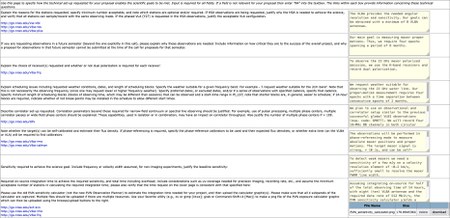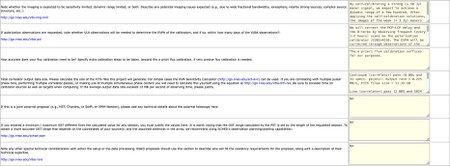Technical Justification
Many new (and even some experienced) VLBA users are intimidated by the Technical Justification (TJ) portion of the Proposal Submission Tool (PST). However, it may be better to view the TJ section as an opportunity to move some of the technical details out of the Science Justification and make room for more science.
The TJ consists of several sections where users are required to enter brief statements about the technical nature of their proposal. Essentially, this is where users demonstrate that their proposed project is technically feasible and that they have considered various difficulties that may arise.
As you write your science justification, or as you read one that someone else wrote, keep in mind that some details about the planned observations can be put in the TJ instead. It may even be useful to fill in (or at least start to fill in) the TJ before you begin writing the science justification in order to avoid repeating yourself.
The Science Review Panel (SRP) and the Time Allocation Committee (TAC) will both have access to the TJ associated with a proposal. An NRAO staff member will review your TJ before your proposal is given to the SRP. The SRP and the TAC will both have access to any comments from the NRAO Technical Reviewer.
Technical Justification Sections
Stations Requested: Proposers should specify the minimum number of stations needed to achieve their science goals. Also, list any individual stations that are required. Proposers often state that they require both MK and SC in order to get the best possible angular resolution. If Y1 or any HSA stations are needed, explain why they are necessary. It is generally a good idea to assume that at least one, and probably two VLBA stations will be unavailable at any given time. Additionally, triggered proposals that require a rapid response (~1 week or less) should consider only requiring seven stations, only one of which should be an island site. If a proposal states that it requires all ten VLBA stations, it may be difficult to schedule because at least one station is often unavailable due to mechanical problems, poor weather, and/or network issues.
Future Semesters: If the proposed project will require observations in 2 or more semesters, explain why here.
Receivers: List all receivers that will be used, and provide a brief justification for those choices.
Scheduling Issues: List any restrictions on when or how the observations can be done. This includes specifying exact dates for fixed-date projects, stating the minimum length of scheduling blocks, and specifying what weather conditions are acceptable.
Correlator Setup: This section is used to specify what the correlator will do with the data after it has been taken. This should include integration times, observation type (continuum, spectral line, or pulsar), and any other details about the correlation. For example, if the project requires more than one phase center, state that here. NOTE: The recording data rate is not related to the correlator, so you do not need to say anything about "4 Gbps" or "2 Gbps" here.
Self-calibration: State whether or not the science targets are expected to be bright enough for self-calibration. If not, specify which phase reference calibrators you plan to use (if known). If you will need extra time on either the VLA or VLBA to identify good phase reference calibrator sources for your project, you can request that time here.
Sensitivity Required: Clearly state what sensitivity is needed to achieve the science goals. For example, "An image rms of 40 microJy/beam is necessary to detect the core at the 5-sigma level, but we expect the jet component to be much dimmer. We therefore require a sensitivity of 5 microJy/beam."
Integration Time: In this section, state the on-source integration time needed to achieve the sensitivity stated in the previous section. You will also need to provide a screen shot of the EVN Calculator or the pdf from the EVN Observation Planner. If your project will involve observations with more than one receiver, you will need to include a calculator estimate document for each band. NOTE: When calculating the exposure time, remember to use the minimum number of antennas you specified in the first section of the TJ.
Sensitivity or Dynamic Range Limited: Clearly state whether you expect your results to depend on the sensitivity or the dynamic range. If this section is left blank or has "NA", the Technical Reviewer may write something like "This project appears to be sensitivity limited". If you do not want the Reviewers making guesses about your project, make sure you enter something here.
Polarization: If you plan to do any polarimetry with your observation, you may require some VLA observations of polarization calibrators near the time of you VLBA observation. List any calibration sources you intend to use here.
Flux Calibration Accuracy: If you need flux calibration accuracy better than about 10%, state that here and explain how you will achieve this accuracy.
Total Correlator Output Data Size: Give you estimate for the total size of all FITS files that will result from your observation. This should account for all targets (both calibration and science) and all epochs.
Joint Proposal Details: For joint proposals, you will need to enter some extra technical information about the other instrument(s) you requested.
Min/Max GST: If you do not use the default GST range from the Sources section, you will need to explain why here.
Other Considerations: If your project has any additional needs, list them here.
Common Mistakes
The most common mistake proposers make in the TJ section is to miscalculate the time on source necessary for their project. Many times, the proposer will use the EVN Calculator or EVN Observation Planner with all 10 VLBA antennas, but then state that their project can be done with only 8 (or fewer) antennas. This is not always a problem, but it can lead to Technical Review comments like:
“The proposers state that only 8 antennas are needed for the observations, but the on-source time estimate was made using 10 antennas in the EVN Calculator. It is unclear that the requested time is adequate to successfully complete the project with the minimum required number of antennas.”
Another common mistake is when users who are proposing for L (21 cm, 1 GHz) or S (13 cm, 2 GHz) band observations do not take into account the impacts of RFI in those bands. RFI is increasingly a problem at those frequencies and it will have an impact on the usable bandwidth, which results in a reduction in sensitivity. Proposers should assume that between 20% and 30% of the bandwidth will be unusable at L and S bands, an adjust their sensitivity estimate accordingly (see the Exposure and Overhead chapter).
One more common mistake is when a proposer states that they need flux density calibration accurate to 5%, but they do not provide any information about how they will achieve this accuracy. The nominal VLBA flux density accuracy, with standard calibration techniques, is about 10%.
Comments from a Technical Review can impact the SRP’s ranking of projects. Proposals that do not appear technically feasible are often given lower rankings. However, these comments are not always detrimental to a proposal. If the science justification is compelling and the SRP rates the proposal highly, a comment about the on-source time estimate on the TJ could lead to the TAC granting more time than what was requested in order to ensure the project’s success. The Technical Review is not intended to determine which proposals are granted time, but to ensure that successful proposals lead to successful observations.
If you have any questions about the Technical Justification section, please contact NRAO staff via the helpdesk.
Example
Below is an example of a filled TJ is presented below. The example project involves VLBA antennas only (no HSA, no Global VLBI).
 |
 |
| Example of a completed Technical Justification section of the PST. Click on the images for the full-size versions. |




Connect with NRAO